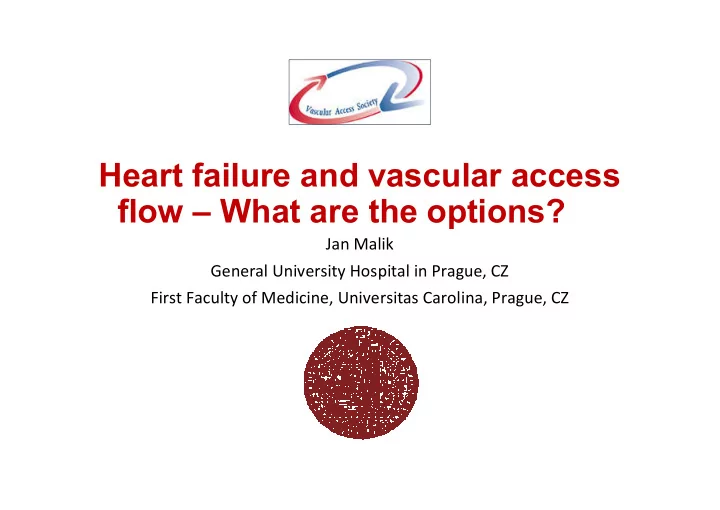

Heart failure and vascular access flow – What are the options? Jan Malik General University Hospital in Prague, CZ First Faculty of Medicine, Universitas Carolina, Prague, CZ
Hemodynamic changes after AV access creation AV access creation AV access creation Decrease of peripheral Decrease of peripheral vascular resistance vascular resistance Feeding artery dilatation Feeding artery dilatation Flow increase Flow increase WSS( τ ) = = WSS( τ) Increase of wall shear Increase of wall shear NO NO (velocity*viscosity)/dia (velocity*viscosity)/dia stress stress meter meter Endothelium Endothelium
Normal brachial artery flow volume : 80-150ml/min Brachial artery flow volume: ESRD pts . 60-120 ml/min Usual flow volume via an AV-access (Qa) : forearm 600-1200 ml/min brachial 800-1500 ml/min Normal resting cardiac output (CO): 4-6 l/min
Consequences of AV-access creation • Flow competition (hand ischemia, AVF-CABG competition...) • Heart failure (de-compensation) • High-output (hyperkinetic) HF • Congestive HF • Pulmonary hypertension
Flow competition The flow is driven by: • perfusion pressure (mean arterial-central venous pressure) cardiac output • vascular resistance www.matrix.co.nz
Cardiac output and access flow (Qa) • Effective CO = total CO-Qa • High-flow AVF: • >1500-2000 ml/min • Qa > 1/3 of CO Basile C, Lomonte C. Semin Dial 2018
Heart failure types • Classic, congestive HF • Relatively or absolutely low CO (COef.) at reast or excercise • Very frequent • High-output HF • Very high CO • Rare
High-output (hyperkinetic) heart failure • Symptoms of heart failure (dyspnoe, fatique) • Signs: BNP, congestion on X-ray, left atrial pressure • High cardiac output indexed to body surface area (CI) • Cut-off values: CI 3.5-3.9 l/min/m 2 • Qa usually > 2000 ml/min • Resolves after banding or other flow reducing procedure Chemla E et al. Semin Dial. 2007;20(1):68-72 Reddy YNV et al. J Am Coll Cardiol 2016;68(5): 473-482
Congestive heart failure • CO (COef.) relatively/absolutely low • Signs: BNP, congestion on X-ray, LV EF, valvular disease.... • Very frequent and associated with mortality • Qa: any value („last drop effect“)
Heart failure: mechanisms at CKD • Coronary artery disease Metabolic changes (phosphates, ADMA, FGF-23, osmolality...) • LV hypertrophy • LV diastolic dysfunction Endocrine changes (RAAS and • LV systolic dysfunction sympathetic activation, parathormone...) • Valvular disease Pressure overload (arterial • RV dysfunction hypertension) • Arrhythmias • Pericardial disease Volume overload (natrium retention, fluids) • Pulmonary hypertension Malik J. J Vasc Access 2018
Volume overload • CKD impaired Na+H 2 O excretion • Fluid retention between HD (associated w. blood pressure disease) • Anemia • AV access flow Increase of cardiac output (CO) Temporary „luxurious“ tissue perfusion Later CO decrease Brod J. Ulster Med J. 1975
Volume overload • CKD impaired Na+H 2 O excretion • Fluid retention between HD (associated w. blood pressure disease) • Anemia • AV access flow Increase of cardiac output (CO) Temporary „luxurious“ tissue perfusion Later CO decrease Brod J. Ulster Med J. 1975
Volume overload:consequences Pulmonary and systemic venous congestion Dyspnoea, edema, impaired organ perfusion Development of LV systolic dysfunction Increased mortality
AVF (Qa) effects on the heart • Cavities enlargement (atria and ventricles) • Increase of filling pressures (diastolic dysfunction) • Hypertrophy • BNP levels • sympathetic aktivity • aortic/arterial stiffness • frequency of dialysis-induced regional LV stunning • of systemic blood pressure • decline of renal function
Frequency of high-flow AVF induced changes • Higher risk of high-flow AVF development: upper-arm AVF, males, previous access surgery, young • The incidence of HF associated w. high-flow AVF requiring surgical correction: 3.7% • Qa>2000 ml/min have a greater tendency to LV dilatation than Qa <1000 ml/min Wijnen E et al. Artif Organs 2005;29:960-964 Chemla ES et al. Semin Dial 2007;20:68-72 MacRae JM et al. J Am Soc Nephrol 2004;15:396A
Cases: our atttempt
Case 1 • 72-y.o.male, on dialysis, shortness of breath NYHA III • Qa 1800 ml/min • Echo: moderate-to severe mitral reg., EF 45% Steps: 1.Dry weight adjustment 2.Anemia correction 3.??flow-reducing surgery??
Lowering of dry weight = de- congestion LV EF Valvular Lowering the size of heart regurgitations cavities However, too low dry weight LV EF Hypotension organ hypoperfusion Decrease of LV filling CO +Qa pressure
Case 2 • 68y.o. lady, NYHA III, fatigueness • Qa 1500 ml/min • BP 130/65mmHg, HR 130/min irreg. • Echo: sligthly dilated, diffusely hypokinetic LV, EF 30% Steps: 1.Arrhythmia control 2.Dry weight adjustment? 3.??flow-reducing surgery??
ad Case 2 • The most frequent arrhythmia is atrial fibrillation • If longer lasting - „tachycardia-induced cardiomyopathy“ LV dilatation, systolic dysfunction
Case 3 • 57y.o. lady • NYHA III, no help of dry weight adjustments • Qa 500 ml/min • ECHO: C0 2.6 l/min, CI 1.8 l/min/m 2 Steps : 1.Revascularization? 2.Resynchronization? 3.AVF ligation, catheter insertion
Case 4 • 54y.o. man practically symptomless • Qa 6200 ml/min • Echo: EF 67%, concentric hypertrophy, dilated left atrium What to do?
Final remarks 1: Indication to flow-reduction: • HF high-output: with CI > 3.5-3.9 l/min/m 2 • HF congestive: symptomatic patients after correction of dry weight, anemia • Always consider Qa in relation to other patient´s characteristics
Final remarks 2: AVF • Is generally the safest dialysis access • Its impact on the circulation is both positive and negative • Individualized approach is a must
Thank you for your attention General University Hospital in Prague
Recommend
More recommend